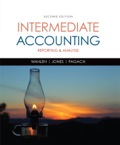
1.
Ascertain the stand-alone selling price of each good or service.
1.
Explanation of Solution
Stand-alone selling price: The “stand-alone selling price” is the price at which promised goods and services is sold individually to a customer. If the “stand-alone selling price” is not identifiable, then the company must use its best estimate to sell goods and services separately.
Stand-alone selling price of each good or service:
| Good or service | Amount |
| Dishwasher | $1,000 |
| Installation | (1)$180 |
| Service contract | (2)$385 |
| Total | $1,565 |
Table (1)
Working notes:
(1)Calculate the stand-alone selling price for installation:
(2)Calculate the stand-alone selling price for service contract:
2.
State the manner in which the transaction price must be allocated among the products.
2.
Explanation of Solution
Transaction price: Transaction price is the amount of consideration that is estimated by the company to be authorized in exchange, for delivering the promised goods and services to the customer. Transaction price is examined by the seller by analyzing the terms of the contract and the normally conducts of the business
Calculate the transaction price for dishwasher:
Therefore, the transaction price for dishwasher is $895.
Calculate the transaction price for installation:
Therefore, the transaction price for installation is $161.
Calculate the transaction price for service contract:
Therefore, the transaction price for service contract is $344.
Note: $1,600=
Want to see more full solutions like this?
Chapter 17 Solutions
EBK INTERMEDIATE ACCOUNTING: REPORTING
 Intermediate Accounting: Reporting And AnalysisAccountingISBN:9781337788281Author:James M. Wahlen, Jefferson P. Jones, Donald PagachPublisher:Cengage LearningPrinciples of Accounting Volume 1AccountingISBN:9781947172685Author:OpenStaxPublisher:OpenStax College
Intermediate Accounting: Reporting And AnalysisAccountingISBN:9781337788281Author:James M. Wahlen, Jefferson P. Jones, Donald PagachPublisher:Cengage LearningPrinciples of Accounting Volume 1AccountingISBN:9781947172685Author:OpenStaxPublisher:OpenStax College

